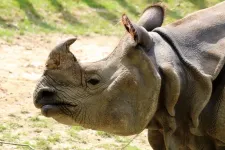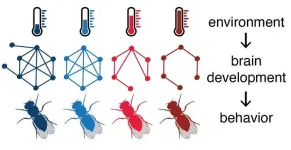(Press-News.org) When water freezes into ice or boils into vapour, its properties change dramatically at specific temperatures. These so-called phase transitions are fundamental to understanding materials. But how do such transitions behave in nanomaterials? In Nature Communications, a team of scientists led by TU Delft (The Netherlands) presents new insights into the complex nature of phase transitions in magnetic nanomaterials. Their findings reveal the coupling between magnetic and mechanical properties, paving the way for ultra-sensitive sensors.
The scientists from TU Delft, together with colleagues from the University of Valencia and the National University of Singapore, studied the 2D nanomaterial FePS₃, which is just a few atoms thick. For the first time, they developed a method to gain deeper insights into the highly complex phase transitions of such materials. By using tiny, suspended membranes of FePS₃, the team vibrated the material at high amplitudes while sweeping the temperature. This revealed how the material’s vibrations change near its phase transition temperature and, with that, its magnetic properties.
“Imagine a drum with a magnetic structure, where the laser light acts as the drumstick—continuously making it vibrate while its rhythm subtly shifts with changing temperature,” explains Farbod Alijani, associate professor at the TU Delft Faculty of Mechanical Engineering. “While warm, this magnetic drum is loose, and its magnetic spins, which are natural turns in particles that make them act like small magnets, are in a disordered phase. But once cold, the drum tightens up, with the spins snapping into an orderly pattern. Now, imagine that while drumming, you slowly change the temperature from warm to cold. As you do, you notice not only when the drum starts to feel different but also that this change isn’t smooth (linear)—it unfolds in an intricate and irregular (nonlinear) manner, affecting its mechanical properties.”
Phase transition temperature
The researchers essentially measured this nonlinear change during the phase transition. By using a nanoscale drum, they could detect the temperature at which this sudden transformation occurs and study how the drum’s mechanical behaviour changes in detail. “We pinpointed the phase transition temperature at around -160°C,” says Makars Šiškins, whose PhD work inspired this study. “Additionally, we found that the changes in the mechanical response driven by the temperature shifts are directly coupled to the material’s magnetic and elastic properties.”
Ultra-sensitive sensors
These membranes are exceptionally sensitive to both internal and external forces. Šiškins adds: “This sensitivity positions them as ideal candidates for sensors capable of detecting even very small environmental changes or internal stresses in the material itself.”
The team plans to apply this methodology to unveil the secrets of phase transitions in other nanomaterials. Co-author Herre van der Zant: “In our lab, we will investigate whether we can detect so-called spin waves with the nanodrum. You can think of spin waves as carriers of information in a magnetic material, much like electrons are for conductive materials.” Alijani will focus on translating these findings into practical applications, such as improving sensor performance. “Understanding these nonlinear processes lays the basis for innovative nanomechanical devices, including ultra-sensitive sensors,” he notes.
END
Decoding nanomaterial phase transitions with tiny drums
In Nature Communications, a team of scientists led by TU Delft (The Netherlands) presents new insights into the complex nature of phase transitions in magnetic nanomaterials. Their findings pave the way for ultra-sensitive sensors.
2025-03-12
ELSE PRESS RELEASES FROM THIS DATE:
Two-star system explains unusual astrophysical phenomenon
2025-03-12
(Images available via the links in the Notes section) An international team of astrophysicists led by the Netherlands and the UK have discovered that radio pulses lasting seconds to minutes are due to two stars coming together – rather than emissions from a single star. The results are published today (12 March) in Nature Astronomy.
In recent years, a new astronomical phenomenon has puzzled radio astronomers: researchers have detected radio pulses from the Milky Way that last from seconds to minutes. These pulses are unlike anything expected from known radio-emitting neutron stars, or pulsars*, ...
Minimal TV viewing may be protective for heart diseases linked to Type 2 diabetes
2025-03-12
Research Highlights:
A sedentary lifestyle such as watching TV (two or more hours daily) may be a key factor in the risk of developing heart and blood vessel diseases, according to an analysis of health records from a large U.K. biomedical database.
People with higher genetic risk for Type 2 diabetes may be more likely to have a heart attack, stroke or other types of atherosclerotic cardiovascular disease. However, limiting TV watching to no more than one hour a day may help offset the increased risk of these ...
Mass General Brigham study finds relationship between doomsday clock and patterns of mortality and mental health in the united states
2025-03-12
Results indicate the closer the Doomsday Clock ticks to midnight, the higher the rates are for mortality specific to Alzheimer’s disease, suicide, unintentional injuries, alcohol and substance-related disorders
Since 1947, the Bulletin of the Atomic Scientists (BAS) has used the metaphor of the Doomsday Clock as a means of communicating how close the human species is to self-imposed annihilation, represented as midnight. While early iterations of the clock focused more exclusively on the dangers of nuclear weapons, the BAS has also begun to consider other evolving existential dangers ...
Signs of ‘tipping point’ to electric vehicles in UK used car market
2025-03-12
Second-hand electric cars may be close to a “tipping point” where they become more popular than equivalent petrol and diesel cars in the UK, new research shows.
Researchers analysed data from car sales website Auto Trader, comparing daily views of adverts for electric vehicles (EVs) with petrol/diesel cars.
Interest in second-hand EVs grew rapidly, doubling from 3.5% of advert views in 2022 to 7% in 2023.
Importantly, interest in EVs became more “sticky”. Events such as petrol price increases drove extra EV views – and over time these spikes of attention lasted longer and longer.
“To identify ...
A new name for one of the world's rarest rhinoceroses
2025-03-12
A new study revealed significant differences in the appearance and behaviour of the two one-horned Asiatic rhinoceros species, challenging long-standing classifications and supporting a re-evaluation of their status.
The study, led by zoologist Francesco Nardelli and paleontologist Kurt Heißig, highlights how millions of years of evolutionary pressures have shaped the distinct adaptations of the Indian (Rhinoceros unicornis) and Sundaic (Rhinoceros sondaicus) rhinoceroses. The critically endangered Sundaic rhinoceros has a slender skull, a broader and lower back of the head, and a shorter nose and teeth suited for browsing leaves. In contrast, the ...
Why do children use loopholes? New research explains the development of intentional misunderstandings in children
2025-03-12
Most people are familiar with loopholes. When your boss, landlord, partner, customer, or government asks you to do something you don’t want to do, and yet you can’t say “no,” you may resort to malicious compliance – doing what someone asked, but not actually what they meant. Most parents are probably familiar with such “little lawyer” behavior too: if a parent says, “Time to put the tablet down,” a child might physically put the tablet down on the table – and then keep playing on it. While such ...
How satisfied are you with your mattress? New research survey aims to find out
2025-03-12
Sleep quality is a crucial aspect of health, yet while adults spend around a third of their lives sleeping, there is surprisingly little research on mattresses. Mass General Brigham researchers developed and tested the Boston Mattress Satisfaction Questionnaire (BMSQ), a new tool to rigorously assess mattress satisfaction and characteristics.
They administered the BMSQ to a representative sample of over 1,000 adults in the United States, finding that the tool is internally consistent and viable for assessing mattress ...
Democracy first? Economic model begs to differ
2025-03-12
Recent studies on economic growth report that preventing the abuse of state power through democratic institutions is critical to a nation’s development. However, there has been little prior research on how societies transition in response to the two conflicting goals of limiting the state’s stranglehold on governance while improving its administrative capacity through citizens’ political participation.
Osaka Metropolitan University Associate Professor Ryosuke Okazawa of the Graduate School of Economics led a team that ...
Opening a new chapter in 3D microprinting with the dream material 'MXene'!
2025-03-12
The Smart 3D Printing Research Team at KERI, led by Dr. Seol Seung-kwon, has developed the world’s first technology for printing high-resolution 3D microstructures using 'MXene,' a material known as the dream material.
MXene, first discovered in the United States in 2011, is a two-dimensional nanomaterial composed of alternating metal and carbon layers. MXene possesses high electrical conductivity and electromagnetic shielding capabilities. Due to its easy combination with various metal chemicals, MXene has gained significant attention ...
Temperature during development influences connectivity between neurons and behavior in fruit flies
2025-03-12
The rate of development of poikilothermic animals, such as insects, fish, and reptiles, is determined by environmental temperature. A research team at Johannes Gutenberg University Mainz (JGU) has recently demonstrated how temperature can affect brain development in fruit flies. "In the area of the brain we examined, neurons formed more synapses and connected to more synaptic partners at lower temperatures," stated Dr. Carlotta Martelli, head of the team at the Institute of Developmental Biology and Neurobiology of JGU. In their study, the scientists focused on the olfactory circuit of Drosophila melanogaster, because the sense of smell determines important behavioral patterns in ...
LAST 30 PRESS RELEASES:
Tracing the quick synthesis of an industrially important catalyst
New software sheds light on cancer’s hidden genetic networks
UT Health San Antonio awarded $3 million in CPRIT grants to bolster cancer research and prevention efforts in South Texas
Third symposium spotlights global challenge of new contaminants in China’s fight against pollution
From straw to soil harmony: International team reveals how biochar supercharges carbon-smart farming
Myeloma: How AI is redrawing the map of cancer care
Manhattan E. Charurat, Ph.D., MHS invested as the Homer and Martha Gudelsky Distinguished Professor in Medicine at the University of Maryland School of Medicine
Insilico Medicine’s Pharma.AI Q4 Winter Launch Recap: Revolutionizing drug discovery with cutting-edge AI innovations, accelerating the path to pharmaceutical superintelligence
Nanoplastics have diet-dependent impacts on digestive system health
Brain neuron death occurs throughout life and increases with age, a natural human protein drug may halt neuron death in Alzheimer’s disease
SPIE and CLP announce the recipients of the 2025 Advanced Photonics Young Innovator Award
Lessons from the Caldor Fire’s Christmas Valley ‘Miracle’
Ant societies rose by trading individual protection for collective power
Research reveals how ancient viral DNA shapes early embryonic development
A molecular gatekeeper that controls protein synthesis
New ‘cloaking device’ concept to shield sensitive tech from magnetic fields
Researchers show impact of mountain building and climate change on alpine biodiversity
Study models the transition from Neanderthals to modern humans in Europe
University of Phoenix College of Doctoral Studies releases white paper on AI-driven skilling to reduce burnout and restore worker autonomy
AIs fail at the game of visual “telephone”
The levers for a sustainable food system
Potential changes in US homelessness by ending federal support for housing first programs
Vulnerability of large language models to prompt injection when providing medical advice
Researchers develop new system for high-energy-density, long-life, multi-electron transfer bromine-based flow batteries
Ending federal support for housing first programs could increase U.S. homelessness by 5% in one year, new JAMA study finds
New research uncovers molecular ‘safety switch’ shielding cancers from immune attack
Bacteria resisting viral infection can still sink carbon to ocean floor
Younger biological age may increase depression risk in older women during COVID-19
Bharat Innovates 2026 National Basecamp Showcases India’s Most Promising Deep-Tech Ventures
Here’s what determines whether your income level rises or falls
[Press-News.org] Decoding nanomaterial phase transitions with tiny drumsIn Nature Communications, a team of scientists led by TU Delft (The Netherlands) presents new insights into the complex nature of phase transitions in magnetic nanomaterials. Their findings pave the way for ultra-sensitive sensors.






